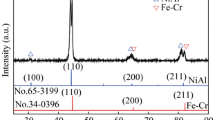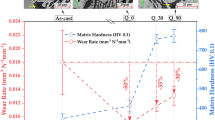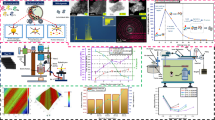Abstract
The response of the Al-4.5 wt pct Cu-5 wt pct TiB2 in-situ composite in the as-cast, hot-rolled, mushy-state rolled, or pre-cold rolled mushy-state rolled conditions to dry sliding wear tests at 1 m/s linear speed under 20N load has been examined. Further, microstructures and chemical compositions were simultaneously studied by scanning electron microscopy and energy dispersive X-ray spectroscopy, respectively, whereas the microtexture was quantified by electron backscattered diffraction (EBSD) analysis. An effort has been made to understand the relationship of CuAl2 and TiB2 particle distribution, microtexture, and hardness obtained through the aforementioned rolling processes with wear rates and post-wear surface profile. Additionally, the amount and depth of work hardening as a result of wear has been correlated with the subsurface microtexture evolution. Among the investigated wear-tested samples, the pre-cold rolled mushy-state rolled composite (PCMRC) has shown the best wear resistance due to high hardness being contributed by the highest low-angle boundary (LABs; misorientation angles < 15 deg) density, and a more homogeneous distribution of second-phase particles, which help in resisting the surface abrasion by forming a uniform mechanically mixed layer (MML). The MML primarily consists of the oxides of Al and Fe coming from the rotating steel disc during dry sliding wear tests, and acts as a lubricating medium, leading to the lowest coefficient of friction for the PCMRC. Examination of the subsurface of post-wear hot-rolled composite by EBSD has shown the presence of extremely deformed grains with a high density of LABs, thereby forming a fine sub-grain structure, which replaces its typical initial recrystallized equiaxed strain-free grain structure. In contrast, post-wear MRC and PCMRC samples, which exhibited a high density of LABs before the wear test, have shown a relatively lower density of LABs along with the formation of finer Al grains adjacent to the particles. Grain refinement in subsurface locations of MRC and PCMRC during wear is either ascribed to increase in misorientations of pre-existing LABs to angles > 15 deg due to considerable strain accumulation near TiB2 particles or particle-stimulated nucleation by dynamic recrystallization due to flash heat generation. Furthermore, a remarkable increase in the post-wear microhardness of the subsurface locations has been used to confirm that significant work hardening is caused by severe plastic deformation of the composite matrix during wear, which is in great coherence with the results of EBSD analysis.













Similar content being viewed by others
Data Availability
The raw/processed data that have been used to generate these findings cannot be shared at this time, as the data also form part of ongoing research.
References
J.W.H. Hunt: Materials Science Forum, 2000, vol. 331-337, pp. 71-84.
S. Suresh, N. Shenbag, V. Moorthi: Procedia Engineering, 2012, vol. 38, pp. 89-97..
Q.D. Qin, Y.G. Zhao, W. Zhou: Wear, 2008, vol. 264, pp. 654-661.
M.B. Karam, A. AlperCerit, B. Selçuk, F. Nair: Wear, 2012, vol. 289, pp. 73–81
A.P. Sannino, H.J. Rack: Wear, 1995, vol. 189, pp. 1-19.
J. Singh, A. Chauhan: Ceramics International, 2016, vol. 42, pp. 56-81.
A. Pramanik: Transactions of Nonferrous Metals Society of China, 2016, vol. 26, pp. 348-358.
A. Sreenivasana, S. PaulVizhianb, N. D. Shivakumar, M. Munirajua, and M. Raguraman: Latin American journals of solids and structures, 2011, vol. 8, pp. 1-8.
S. Basavarajappa, G. Chandramohan, R. Subramanian, and A. Chandrasekar: Mat.Sci., 2006, vol. 24, pp. 357-366.
B. Venkataraman, G. Sundararajan: Acta Materialia, 1996, vol. 44, pp. 451-460.
M. Roy, B. Venkataraman, V.V. Bhanuprasad, Y.R. Mahajan, G. Sundararajan: Metallurgical Transactions A, 1992, vol. 23, pp. 2833-2847.
S. Wilson, A. T. Alpas: Wear, 1997, vol. 212, pp. 41-49.
L. Cao, Y. Wang, C. K. Yao: Wear, 1990, vol. 140, pp. 273-77.
C. A. Caracostas, W. A. Chiou, M. E. Fine, H. S. Cheng: Scripta Metallurgica et Materialia, 1992, vol. 27, pp. 167-172.
C. A. Caracostas, W. A. Chiou, M. E. Fine, H. S. Cheng: Metallurgical and Materials Transactions A, 1997, vol. 28, pp. 491-502.
A. Mandal, M. Chakraborty, B. S. Murty: Wear, 2007, vol. 262, pp. 160-166.
S. Peddavarapu, R. Jayendra Bharathi: Materials Today: Proceedings, 2018, vol. 5, pp. 14507-14511.
J. M. Shockley, E. F. Rauch, R. R. Chromik, S. Descartes: Wear, 2017, vol. 376-377, pp. 1411-1417.
G. Huang, W. Hou, J. Li, Y. Shen: Surface and Coatings Technology, 2018, vol. 344, pp. 30-42.
N. Soltani, H. R. JafariNodooshan, A. Bahrami, M. I. Pech-Canul, W. Liu, G. Wu: Materials & Design, 2014, vol. 53, pp. 774-781.
I. G. Siddhalingeshwar, M. A. Herbert, M. Chakraborty, R. Mitra: Materials Science and Engineering: A, 2011, vol. 528, pp. 1787-1798.
M. A. Herbert, R. Maiti, R. Mitra, M. Chakraborty: Wear, 2008, vol. 265, pp. 1606-1618.
I. G. Siddhalingeshwar, D. Deepthi, M. Chakraborty, R. Mitra: Wear, 2011, vol. 271, pp. 748-759.
K. Pavitra, R. Mitra: Materials Science and Engineering: A, 2012, vol. 557, pp. 84-91.
B. N. Mordyuk, G. I. Prokopenko, Y. V. Milman, M. O. Lefimov, K. E. Grinkevych, A.V. Sameljuk, I.V. Tkachenko: Wear, 2014, vol. 319, pp. 84-95.
M. R. Rosenberger, C. E. Schvezov, E. Forlerer: Wear, 2005, vol. 259, pp. 590-601.
D. A. Rigney: Wear, 2000, vol. 245, pp. 1-9.
X.Y. Li, K. N. Tandon: Wear, 1997, vol. 203-204, pp. 703-708.
H. C. How, T. N. Baker: Wear, 1999, vol. 232, pp. 106-115.
B. Venkataraman, G. Sundararajan: Acta Materialia, 1996, vol. 44, pp. 461-473.
S.V. Prasad, J. R. Michael, T. R. Christenson: Scripta Materialia, 2003, vol. 48, pp. 255-260.
M. A. Herbert, C. Sarkar, R. Mitra, M. Chakraborty: Metallurgical and Materials Transactions A, 2007, vol. 38, pp. 2110-2126.
M. Mandal, R. Mitra: JOM, 2016, vol. 68, pp. 1902-1908.
M. Mandal, R. Mitra: Materials Science and Engineering: A, 2019, vol. 760, pp. 88-104.
M. Mandal, R. Mitra: Materials Characterization, 2018, vol. 146, pp. 267-278.
F. J. Humphreys: Acta Metallurgica, 1977, vol. 25, pp. 1323-1344.
J. Jiang, F. H. Stott, M. M. Stack: Wear, 1994, vol. 176, pp. 185-194.
R. Saraswat, A. Yadav, R. Tyagi: Materials Today: Proceedings, 2018, vol. 5, pp. 16963-16972.
C. M. Rao, K. Mallikarjuna Rao: Materials Today: Proceedings, 2018, vol. 5, pp. 268-275.
V. Mohanavel, K. Rajan, S. SureshKumar, A. Chockalingam, A. Roy, T. Adithiyaa: Materials Today: Proceedings, 2018, vol. 5, pp. 1740-1746.
S. Dayanand, S. Babu, B. V. Auradi: Materials Today: Proceedings, 2018, vol. 5, pp. 22536-22542.
M. Kawamoto, K. Okabayashi: Wear, 1980, vol. 58, pp. 59-95.
J. F. Archard: Wear, 1959, vol. 2, pp. 438-455.
H.V. Atkinson, K. Burke, G. Vaneetveld: Materials Science and Engineering: A, 2008, vol. 490, pp. 266-276.
Acknowledgments
The authors wish to thank the technicians of the melting casting lab, mechanical testing lab, and workshop of the Metallurgical and Materials engineering department for extending their help during the experimental works. The authors are grateful to the Central Research Facility (CRF) of Indian Institute of Technology Kharagpur for letting us perform all the required characterizations. The research did not receive any specific grant from funding agencies in the public, commercial, or not-for-profit sectors.
Author information
Authors and Affiliations
Corresponding author
Additional information
Publisher's Note
Springer Nature remains neutral with regard to jurisdictional claims in published maps and institutional affiliations.
Manuscript submitted January 10, 2019.
Rights and permissions
About this article
Cite this article
Mandal, M., Mitra, R. Study of Dry Sliding Wear Behavior of Hot-Rolled and Mushy-State Rolled Al-4.5Cu-5TiB2 In-Situ Composite with Analysis of Work Hardening and Subsurface Microstructure-Microtexture Evolution Using EBSD. Metall Mater Trans A 50, 5356–5372 (2019). https://doi.org/10.1007/s11661-019-05406-7
Received:
Published:
Issue Date:
DOI: https://doi.org/10.1007/s11661-019-05406-7




